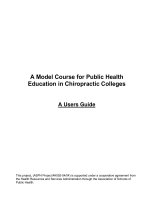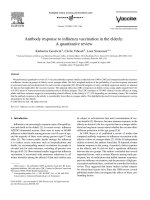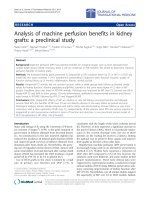Nursing Practice In Multiple Sclerosis: A Core Curriculum doc
Bạn đang xem bản rút gọn của tài liệu. Xem và tải ngay bản đầy đủ của tài liệu tại đây (991.02 KB, 130 trang )
This page intentionally left blank
Nursing Practice in
Multiple Sclerosis:
A Core Curriculum
Kathleen Costello, RN, MS, CRNP, MSCN
Maryland Center for Multiple Sclerosis
University of Maryland
Baltimore, Maryland
June Halper, MSCN, ANP, FAAN
Gimbel Multiple Sclerosis Center,
Consortium of Multiple Sclerosis Centers (CMSC)
Teaneck, New Jersey
and
Colleen Harris, RN, MN, MSCN
Multiple Sclerosis Clinic
Foothills Hospital
Calgary, Alberta
Core Curriculum 00 10/23/02 12:18 PM Page i
Demos Medical Publishing, 386 Park Avenue South, New York, New York 10016
© 2003 by Demos Medical Publishing. All rights reserved. This book is protected by
copyright. No part of it may be reproduced, stored in a retrieval system, or transmit-
ted in any form or by any means, electronic, mechanical, photocopying, recording,
or otherwise, without the prior written permission of the publisher
Library of Congress Cataloging-in-Publication Data
Costello, Kathleen.
Nursing practice in multiple sclerosis : a core curriculum / Kathleen Costello,
June Halper, and Colleen Harris.
p. ; cm.
ISBN 1-888799-76-5 (pbk.)
1. Multiple sclerosis—Nursing.
[DNLM: 1. Multiple Sclerosis—nursing. WL 360 C84 In 2003] I. Halper, June.
II. Harris, Colleen. III. Title.
RC377 .C66 2003
610.73'69—dc21
2002151624
Printed in Canada
Visit the Demos Medical Publishing web site at www.demosmedpub.com
Dedication
This work is dedicated to all of our MS patients and families who have
taught us the meaning of strength and hope in the face of adversity,
and to our MS team throughout the world.
In memory of Morris Halper, M.D., whose spirit lives on in the work
of June Halper.
Acknowledgments
We would like to acknowledge Dr. Diana M. Schneider for her support
of MS nursing and her skill and editorial support in the development
of this resource for MS nurses.
We would also like to thank TevaNeuroscience, especially Judith K.
Katterhenrich, for their encouragement and collaborative spirit.
Core Curriculum 00 10/23/02 12:18 PM Page ii
iii
Preface: Kathleen Costello, RN, MS, CRNP, MSCN v
Background Information for Nursing Practice
in Multiple Sclerosis
1. The History of Multiple Sclerosis Care 1
2. Domains of Multiple Sclerosis Nursing Practice 7
3. Change Theory and Its Application in
Multiple Sclerosis Nursing 11
4. Multiple Sclerosis Nurses’ Code of Ethics 13
The Diagnosis of Multiple Sclerosis
5. Epidemiology 17
6. The Complete Neurologic Examination 21
7. Magnetic Resonance Imaging (MRI) 27
8. Determining the Diagnosis and Prognosis
of Multiple Sclerosis 31
Management of the Disease Process
9. The Immune System and Its Role in Multiple Sclerosis 39
10. Disease-Altering Therapies 43
Functional Alterations: Physical Domains
11. The Symptom Chain in Multiple Sclerosis 51
Contents
12. The Multiple Sclerosis Care Team 65
13. Bladder Dysfunction 69
14. Bowel Elimination and Continence 75
15. The Nurse’s Role in Advanced Multiple Sclerosis 81
Functional Alterations: Personal Domain
16. Psychosocial Implications 85
17. Financial and Vocational Concerns 87
Shaping Multiple Sclerosis Nursing Practice
18. Primary Care Needs 91
19. The Nurse’s Role in Multiple Sclerosis Research 95
20. Study Guide in Multiple Sclerosis 99
21. Case Studies 101
22. Certification Study Questions 113
iv CONTENTS
Core Curriculum 00 10/23/02 12:18 PM Page iv
v
Preface
Multiple sclerosis is a lifelong, potentially disabling disease of the central
nervous system that affects the white matter tracts of the central nervous
system in a sporadic and unpredictable manner. The disease produces
inflammation and demyelination of the white matter, as well as varying
amounts of damage and destruction to the underlying axon. The onset
of disease is most often in early adulthood. Individuals experience a myr-
iad of symptoms with likely progression of disability over time.
Symptoms may include fatigue, visual disturbances, sensory changes,
incoordination, pain, tremor, elimination dysfunction, and cognitive
impairment. Symptoms usually occur as relapses early in the disease, or
as symptoms that appear over 24–48 hours and recede to some extent
over weeks to months. After a decade or so, many individuals experience
fewer relapses, but in their place is a slow progression of MS symptoms
that often leads to increased functional disability over time. A small per-
centage of patients will experience progression from the onset of the dis-
ease and experience progressive mobility impairment over time.
MS invades every aspect of life, and patients as well as families can
be severely affected. Patients and families experience a sense of loss,
both real and perceived. The disease can adversely impact the roles of
provider, spouse, parent, friend, and employee. There are emotional
consequences of the disease as well as physical ones. As the disease is
one for life, individuals and families will have multiple needs
throughout their lives. They will need emotional support, education,
symptom management, adaptation to changes, adaptive equipment,
supportive care, and perhaps even end of life care.
Nursing is a critical element in meeting the multiple needs of the
MS patient and family. MS nurses have evolved from home-based care
providers giving support to the disabled person to certified MS nurs-
es and advanced practice nurses who must be well educated in the
disease process and the available treatments. In addition, MS nurses
must be sensitive to and supportive of the emotional needs of those
affected by the disease. MS nurses must provide appropriate educa-
Core Curriculum 00 10/23/02 12:18 PM Page v
tion regarding the disease process, treatment regimes, symptom man-
agement, and community resources.
As MS knows few borders, MS nurses are needed throughout the
world. Nurses need to share experiences and knowledge to support
MS patients and families as well as each other. Through the vision of
June Halper, MSCN, ANP, FAAN, the International Organization of
Multiple Sclerosis Nurses (IOMSN) was founded in 1997. Its mission
is to establish and perpetuate a specialized branch of nursing in mul-
tiple sclerosis; to establish standards of nursing care in multiple scle-
rosis; to support multiple sclerosis nursing research; to educate the
healthcare community about the disease; and to disseminate this
knowledge throughout the world. The ultimate goal of the IOMSN is
to improve the lives of everyone affected by multiple sclerosis through
the provision of appropriate healthcare services.
This IOMSN determined that the expertise of the MS nurse need-
ed to be developed and recognized. To that end an international cer-
tification board, separate from the IOMSN, was established and a cer-
tification process was developed. The first MS nursing certification
exam was given on June 5, 2002 in Chicago, Illinois. Over 100 nurs-
es from around the world sat for this exam. Prior to the exam several
review courses were held in various locations. It was clear following
the review courses that a tremendous amount of knowledge is need-
ed to be an “expert” in MS nursing.
This core curriculum summarizes in outline form the basic con-
cepts of multiple sclerosis and MS nursing. Each chapter provides rel-
evant information as well as references for further study. Readers will
learn about the history of MS, as well as the current theories regard-
ing the immunologic basis for the disease. Pharmacologic strategies
that include treatment for acute attacks, immunomodulating thera-
pies, and symptomatic therapies are discussed, as are nonpharmaco-
logic interventions.
This text provides the reader with essential information about mul-
tiple sclerosis and its management. It is an excellent review for those
interested in MS nursing certification, and an excellent resource and
reference for the MS nurse. Through the dedicated efforts of June
Halper, this core curriculum is available to all of us involved with the
care of persons with MS.
Kathleen Costello, RN, MS, CRNP, MSCN
President, International Organization of
Multiple Sclerosis Nurses (IOMSN)
vi PREFACE
Core Curriculum 00 10/23/02 12:18 PM Page vi
1
■
Multiple sclerosis (MS) is a common neurologic disease of
young adults. It affects people in the prime of their lives with
unpredictability and uncertainty.
■
In recent decades the hallmark of disease progression has been
altered due to disease-modifying therapies for relapsing forms of
the disease.
■
It has been known as a peculiar disease state (Robert Carswell),
a gray degeneration of the cord (Jean Cruveilhier), and insular
sclerosis (William Moxon and William Osler).
■
Disseminated sclerosis was a term used in the early part of the
twentieth century.
■
The name “multiple sclerosis” is a derivation from the German
“multiple sklerose.”
■
Early cases were:
A. Saint Lidwina van Schiedam
B. Halla, the drummer Bock, and William Brown, a Hudson Bay
official
C. Sir Augustus d’Este
D. Heinrich Heine
E. Margaret Gatty
Chapter 1
The History of Multiple
Sclerosis Care
Objectives:
Upon completion of this chapter, the learner will:
◆ Identify the evolution of knowledge that has impacted the
care of people with multiple sclerosis (MS)
◆ Discuss turning points in the definition of MS
◆ Describe the networks in MS care
Core Curriculum 01 10/23/02 12:19 PM Page 1
F. W .N.P. Barbellion
■
An early monograph on MS was written by Charles Prosper Ollivier.
■
Other writings on MS were by Robert Carswell, Jean Cruveilhier,
Marshall Hall, and others. These included anatomic depictions of
autopsy findings and the description included a clinical history.
■
Jean-Martin Charcot framed the disease and thoroughly described
the clinical and pathologic features of MS in 1868. He added to
the observations of Carswell, Cruveilhier, and the German
physician von Frerichs with his own, calling the disease le sclerose
en plaques or scarring in patches.
■
In 1873, Dr. Moxon in England characterized the disease based
on observations.
■
In 1878, Dr. Ranvier discovered myelin.
■
For over 100 years, physicians were frustrated trying to identify
the cause of MS. Theories of causation ranged from infection to
genetics, vascular problems, and immunologic deficits.
■
In 1916, Dr. Dawson at the University of Edinburgh in Scotland
used a microscope to describe inflammation around the blood
vessels and the damage to the myelin with a clarity and thorough-
ness that has never been improved. Little was known about the
brain’s function, so the meaning of these changes was only a guess.
■
In 1919, abnormalities in cerebrospinal fluid (CSF) were
observed. The significance was unknown.
■
In 1925, the first electrical recording of nerve transmission was
made by Lord Edgar Douglas Adrian. The science of electro-
physiology established techniques needed to study nerves.
■
In 1928, myelin was studied under a microscope; oligodendro-
cytes (cells that produce myelin) were discovered.
■
In 1935, Dr. Rivers at the Rockefeller Institute in New York
reproduced the autoimmune response classically seen in MS. An
animal model for MS was developed called experimental allergic
encephalomyelitis (EAE).
■
Dietary modification was studied with no conclusive evidence of
benefit.
■
Alternative or complementary therapies emerged as a frequently
used supplement or a substitute for conventional treatments.
■
In 1946, Sylvia Lawry founded the National Multiple Sclerosis
Society in New York City, which has expanded into a worldwide
2 NURSING PRACTICE IN MULTIPLE SCLEROSIS: A CORE CURRICULUM
Core Curriculum 01 10/23/02 12:19 PM Page 2
MS Network of MS Societies. Services and programs include a
wide range of patient and family services, basic and psycho-
social research, and MS education. NMSS and the Canadian
MS Society cover North America with a wide range of programs
and services.
■
Dr. Kabat at Columbia University received the first NMSS grant to
study MS.
■
Dr. Salk received an NMSS grant to study the immunology of MS.
■
In 1950, NMSS helped to establish a new division of the National
Institute of Health (NIH), the National Institute for Neurologic
Disorders and Stroke (NINDS).
■
In 1967, Ms. Lawry founded the International Federation of MS
Societies, now the Multiple Sclerosis International Federation
(MSIF).
■
In 1969, the first successful clinical trial in the treatment of MS
was held.
A. Placebo controlled
B. New rating scales and diagnostic standards used
C. Patients were given ACTH
■
In the 1970s, research produced useful results.
A. Scientists studying EAE suspected myelin protein fragments
prevented the disease
B. A mixture of the fragments was used to treat animals and then
humans with MS (copolymer 1)
C. Steroids were now widely used to suppress immune response
D. In 1978, computed tomography (CAT) scanning was first used
for patients with MS
E. First experiments with interferons demonstrated their immune-
modulating effects
■
The 1980s saw the beginnings of major clinical trials in MS using
immunomodulators, such as interferons and glatiramer acetate
(copolymer 1).
■
Dr. Young performed the first magnetic resonance imaging (MRI)
on a patient with MS.
■
In 1984, it became apparent that MRI can visualize MS attacks in
the brain, including many that did not manifest symptoms.
■
In 1993, FDA approved Betaseron
®
(IFN-beta 1b) for relapsing
remitting MS (R-R MS).
CHAPTER 1: THE HISTORY OF MULTIPLE SCLEROSIS CARE 3
Core Curriculum 01 10/23/02 12:19 PM Page 3
■
In 1996, Avonex
®
(IFN-beta 1a) was approved for R-R MS.
■
In 1996, Copaxone
®
(glatiramer acetate) was approved for R-R MS.
■
In 1986, the Consortium of Multiple Sclerosis Centers (CMSC)
was founded. The CMSC is the largest organization of MS health
professionals in the world. It holds annual and regional meetings,
consensus conferences, and training programs for MS profession-
als. It has a journal (International Journal of MS Care) and a
newsletter (The MS Exchange). The CMSC Foundation funds schol-
arships and fellowships in MS training; the CMSC NARCOMS
project has a large patient database to increase understanding of
MS and its ramifications. Many studies have used the database.
■
In 1991 Rehabilitation in Multiple Sclerosis (RIMS), a European
network, was founded. The European Committee on Treatment
and Research in MS (ECTRIMS) was founded shortly thereafter.
ACTRIMS, the North American counterpart, was established fol-
lowed by LACTRIMS, a Latin American organization representing
Central and South America.
■
In 1997, the International Organization of MS Nurses (IOMSN)
was founded. The Goals and Strategies of the IOMSN are to:
A. Facilitate the development of a specialized branch of nursing
in MS:
1. Develop and maintain a mechanism by which members can
share information on practice positions and resources
2. Establish the IOMSN as a forum for discussion and collabo-
ration on issues that concern MS nurses
3. Serve as a resource for external organizations related to MS
practice issues
4. Promote the acknowledgment of the contribution of IOMSN
as the pre-eminent organization of MS nurses
5. Participate with other nursing organizations involved in MS
care or related fields
6. Share information on research activities among members
B. Establish standards of nursing care in MS:
1. Develop minimal standards of nursing practice in MS
2. Facilitate the development of a core curriculum for MS nurs-
ing to disseminate this information
3. Identify specific domains of MS nursing and define basic
roles and responsibilities in each domain
4 NURSING PRACTICE IN MULTIPLE SCLEROSIS: A CORE CURRICULUM
Core Curriculum 01 10/23/02 12:19 PM Page 4
C. Support multiple sclerosis nursing research, basic research,
and clinical trials:
1. Encourage research activities that contribute to the
development of a sound theoretical basis for MS practice
2. Recommend research topics for educational sessions at
IOMSN meetings for dissemination of evidence-based
information
3. Develop and implement nursing research
4. Disseminate MS nursing research findings through
publications and educational activities
D. Educate the healthcare community about MS:
1. Promote communication among the IOMSN membership
via the newsletter, web site, and other venues
2. Facilitate internal and external communication about MS
care and research
■
Multiple Sclerosis International Credentialing Board (MSNICB)
was founded in 2001
A. The MSNICB is responsible for the development and
administration of the Certification examination in
MS nursing.
B. The International Organization of Multiple Sclerosis Nurses
(IOMSN) endorses the concept of voluntary certification by
examination for all nursing professionals providing care in MS.
Those who work or have worked in this specialty and meet
eligibility requirements may be candidates to take this exami-
nation. Certification focuses specifically on the individual and
is an indication of knowledge and skills and MS practice. MS
nursing certification provides formal recognition of a level of
knowledge in the field and promotes the delivery of safe and
effective practice in the domains of Clinical Practice (disease
course and classifications, epidemiology and distribution);
Advocacy (ethical practice, negotiating the healthcare system,
empowerment, knowledge of community resources, patient
rights, consultation expertise); Education (principles of teach-
ing/learning, health promotion and change theory, special
populations, professional development); and Research
(evidence-based practice, protection of human subjects,
research terminology and process).
CHAPTER 1: THE HISTORY OF MULTIPLE SCLEROSIS CARE 5
Core Curriculum 01 10/23/02 12:19 PM Page 5
C. All candidates must be licensed nursing professionals with at
least two years’ experience in MS. Candidates must also agree
to adhere to the IOMSN Code of Ethics.
D. The basic content of the examination covers:
1. Basic concepts of MS (disease course classification,
pathophysiology of MS, diagnostic process)
2. Pharmacologic and nonpharmacologic treatment
3. Symptom management
4. Psychosocial intervention
5. Research and education initiatives
6. Patient advocacy
ADDITIONAL READING
Murray TJ. “The History of Multiple Sclerosis.” In: Burks JS, Johnson KP, eds., Multiple
Sclerosis: Diagnosis, Medical Management, and Rehabilitation. New York: Demos Medical
Publishing, 2000; 1-35.
Polman CH, et al. Multiple Sclerosis: The Guide to Treatment and Management, 5th edition. New
York: Demos Medical Publishing, 2001.
Halper J. The Founding of IOMSN and MSNICB. Personal Communication, 2002.
6 NURSING PRACTICE IN MULTIPLE SCLEROSIS: A CORE CURRICULUM
Core Curriculum 01 10/23/02 12:19 PM Page 6
7
■
Nursing domains are considered the full range of nursing practice
that may be called into use to serve the MS patient and the family.
■
MS practice domains are broad areas of accountability.
■
Broad areas of practice include the full range of knowledge, skills,
and tasks of MS nursing responsibility.
■
The domains of MS nursing include:
A. Clinical Practice
B. Advocacy
C. Education
D. Research
■
The universal tasks of MS nursing are:
A. Establishment of a therapeutic partnership
B. Performance of a comprehensive assessment
C. Formulation of a collaborative treatment plan
D. Initiation, facilitation, and maintenance of a treatment regimen
E. Evaluation of a treatment plan
■
Domain: Clinical practice—Knowledge:
A. Pathophysiology of disease:
1. Immune dysfunction
2. Nerve conduction
Chapter 2
Domains of Multiple Sclerosis
Nursing Practice
Objectives:
Upon completion of this chapter, the learner will:
◆ List the four domains of MS nursing
◆ Describe nursing activities related to the core of care
◆ Cite professional responsibilities required to sustain the MS
nursing role
Core Curriculum 02 10/23/02 12:20 PM Page 7
B. Definition, course, and classification
C. Epidemiology and distribution
D. Symptomatology
E. Diagnosis of multiple sclerosis:
1. Presenting symptoms
2. Prognostic indicators
3. Diagnostic tests
F. Clinical practice—Knowledge and skills:
1. Relapse management
2. Disease modifying agents
3. Symptoms and symptom management
4. Psychosocial issues
G. Advocacy tasks
1. Negotiate for the patient and family in the healthcare system
2. Advocate self-care strategies
3. Serve as a consultant
4. Increase awareness of MS in the community
5. Protect patient rights
6. Examine practice outcomes
H.Advocacy requires knowledge and skills:
1. Patient rights
2. Ethical practice
3. Negotiating the healthcare system
4. Empowerment
5. Public speaking
6. Local and national health policy
7. Disease expertise
■
Domain: Education:
A. Patient education:
1. Knowledge of MS
2. Nursing process and theory
3. Principles of teaching/learning
B. Professional development:
1. Role model
2. Mentor
3. Preceptor
4. Public speaker
5. Support group leader
8 NURSING PRACTICE IN MULTIPLE SCLEROSIS: A CORE CURRICULUM
Core Curriculum 02 10/23/02 12:20 PM Page 8
6. Writer
7. Membership in professional organizations
■
Domain: Research:
A. Knowledge of research terminology and process
B. Protection of human subjects
C. Evidence-based practice.
D. Research tasks and skills:
1. Proper sample collection
2. Preparation and documentation
3. Communication skills
4. Research design, ethical principles
5. Drive to increase nursing body of knowledge
REFERENCE
Maloni, H. MSNICB, Toronto, Ontario, Canada. January 2002. Personal communication.
CHAPTER 2: DOMAINS OF MULTIPLE SCLEROSIS NURSING PRACTICE
9
Core Curriculum 02 10/23/02 12:20 PM Page 9
Core Curriculum 02 10/23/02 12:20 PM Page 10
11
■
Systems theory is useful as a framework for viewing change since
it provides a scheme for organizing information.
■
A systems theory model emphasizes unity and holism and seeks
to avoid fragmented approaches.
■
The goal of a systems model is to provide a framework in which
parts are connected and integrated.
■
Open systems freely exchange information and energy as they
attempt to maintain a balanced state.
■
During change, the person of the change agent’s system interacts
with the patient’s system to influence change and adaptation.
■
A change agent must be especially sensitive to feedback in order
to determine how activities, ideas, and new programs are being
accepted.
■
Change must be planned with respect for environmental systems
and resources.
■
The change agent must be astute to recognize biased or erroneous
sources of information so that undue system disruption does not
take place.
■
One must consider the unique and highly personal values of each
individual in order to initiate change.
■
Resistance can be minimized if the change agent keeps the
systems open and dynamic.
Chapter 3
Change Theory and Its
Application in MS Nursing
Objectives:
Upon completion of this chapter, the learner will:
◆ Discuss the conceptual framework of change theory
◆ Describe its application in MS nursing
Core Curriculum 03 10/23/02 12:20 PM Page 11
■
The role of change agent is a challenging opportunity. Power is
derived either from relationships or expertise or both. When the
change agent advocates an innovation that is not satisfactory to
the system, resistance can come into play.
■
These principles can be applied to patient and family education
in terms of:
A. Adapting to new lifestyles related to MS
B. Changing roles and responsibilities
C. Learning and adopting complex protocols to manage MS
D. Adjusting to the dynamic nature of the disease
ADDITIONAL READING
Auger J. Behavioral Systems and Nursing. Englewood Cliffs, N.J.: Prentice Hall, 1976.
Lancaster J. The Nurse as Change Agent. St. Louis: CV Mosby Co., 1982.
12 NURSING PRACTICE IN MULTIPLE SCLEROSIS: A CORE CURRICULUM
Core Curriculum 03 10/23/02 12:20 PM Page 12
13
ANA Code of Ethics for Nurses
1. The nurse, in all professional relationships, practices with
compassion and respect for the inherent dignity, worth, and
uniqueness of every patient, unrestricted by considerations of
social or economic status, personal attributes or the nature of the
health problem.
2. The nurse’s primary commitment is to the patient, whether an
individual, family, group or community.
3. The nurse promotes, advocates for, and strives to protect the
health, safety, and rights of the patient.
Chapter 4
Multiple Sclerosis Nurses’
Code of Ethics
A multiple sclerosis (MS) nurse has a professional moral obliga-
tion. The purpose of this obligation is to guide the MS nurse in
the practice of multiple sclerosis nursing. This moral obligation
is defined as performance of a morally good act, or rather, what
ought to be done or should be done. The multiple sclerosis
nurse provides care to promote the health and well-being of MS
patients and families.
Ethical principles that guide the MS nurse are: beneficence,
nonmaleficence, stewardship, autonomy, and justice.
Beneficence: Moral requirement to promote good
Nonmaleficence: Do no harm
Autonomy: Respect for self-determination
Stewardship: Preserve your own being
Justice: Fair and equitable determination distribution of
resources and fair treatment for individuals and society
Core Curriculum 04 10/23/02 12:21 PM Page 13
4. The nurse is responsible for and accountable for individual
nursing practice and determines the appropriate delegation of
tasks consistent with the nurse’s obligation to provide optimum
patient care.
5. The nurse owes the same duties to self as to others, including
the responsibility to preserve integrity and safety, to maintain
competence, and to continue personal and professional growth.
6. The nurse participates in establishing, maintaining, and improv-
ing healthcare environments and conditions of employment
conducive to the provision of quality healthcare and consistent
with the values of the profession through individual and
collective action.
7. The nurse participates in the advancement of the profession
through contributions to practice, education, administration,
and knowledge development.
8. The nurse collaborates with other health professionals and the
public in promoting community, national, and international
efforts to meet health needs.
9. The profession of nursing, as represented by associations and
their members, is responsible for articulating nursing values, for
maintaining the integrity of the profession and its practices, and
for shaping social policy.
(June 30, 2001 American Nurses Association)
■
Guiding principles of the MS nurse:
A. Seeks what is good for patients and families.
B. Recognizes that quality of life is defined by the person with MS.
C. Recognizes and respects the patient’s right to care regardless
of age, race, gender, ethnicity, religion, lifestyle, sexual
orientation, economic status, or level of disability.
D. Recognizes the patient’s right to MS specialist care.
E. Promotes impartial treatment.
F. Recognizes the patient’s right to treatment and therapies,
including experimental treatments.
G. Recognizes the patient’s right to access to MS drugs.
H.Knows that patients have the right to be informed and under-
stand advanced healthcare directives (living wills and durable
14 NURSING PRACTICE IN MULTIPLE SCLEROSIS: A CORE CURRICULUM
Core Curriculum 04 10/23/02 12:21 PM Page 14
powers of attorney), concerning the right to receive resuscita-
tion, refuse appropriate treatment, request do-not-resuscitate
orders, or request the discontinuation of life support measures.
I. Is responsible for providing information to the MS patient and
family in order to facilitate informed consent for all treatments
and procedures.
J. Participates in research and is aware of the principles of
informed consent, criteria for inclusion and exclusion in
research protocols, and the right of the individual to withdraw
from a protocol at any time.
K. Recognizes and maintains the patient’s privacy, assuring
confidentiality, except when there is a clear, serious, and
immediate danger to the patient or others.
L. Has a moral obligation to offer access to care, cost containment,
and quality care.
M.Affirms that MS patients have a right to be informed, without
bias, coercion, or deception, about treatment options, potential
effect, and adverse effects of treatments.
N.Supports the fact that MS patients have a right to refuse
treatment, continuing to receive alternative care.
O.Recognizes that the MS patient has a right to review his
medical record and the right to have information explained.
P. Requires participation of the MS patient in an ongoing partner-
ship to develop an effective plan of care. This process considers
diversity, individual autonomy, and responsibility.
Q.Practices competently, consulting and referring when indicated
by professional judgment.
R. Takes appropriate action to protect patients from harm when
endangered by incompetent or unethical clinical practice.
S. Promotes and supports improved practice through profession-
alism, education, certification, and nursing research.
T. Promotes local and national efforts to improve public education,
legislation to ensure access to quality care, and long-term care
initiatives that meet the health needs of MS patients and families.
REFERENCE
Maloni, H. MSNICB, Toronto, Ontario, Canada. January 2002. Personal communication.
CHAPTER 4: MULTIPLE SCLEROSIS NURSES’ CODE OF ETHICS
15
Core Curriculum 04 10/23/02 12:21 PM Page 15
This page intentionally left blank
17
■
Research into MS includes epidemiologic inquiries.
■
Epidemiology is the study of the natural history of the disease.
■
The incidence or attack rate is defined as the number of new cases
of the disease beginning in a unit of time within a specified popu-
lation. This is usually given as an annual incidence rate in cases
per 100,000 per year. The date of onset of clinical symptoms
decides the time of accession although, occasionally, the date of
first diagnosis is used.
■
Prevalence is easier to calculate than incidence because all cases
are included regardless of disease duration. Nevertheless, accurate
assessment of prevalence is still difficult because of the difficulty
of full disease ascertainment.
■
The point prevalence rate is more properly called a ratio and refers
to the number of diagnoses within the community.
■
The major clinical criteria in current use for MS are those by the
Poser committee and a recent set of criteria that includes cases
with monosymptomatic onset proposed by McDonald that
strongly emphasizes MRI findings.
■
Kurtzke classified MS prevalence rates into high, medium, and low
risk groups. High-risk areas such as northern and central Europe,
Chapter 5
Epidemiology
Objectives:
Upon completion of this chapter, the learner will:
◆ Describe the difference between disease incidence and prevalence
◆ Provide an overview of the epidemiology of multiple sclerosis
◆ Discuss the implications of MS epidemiology in patient and
family education
Core Curriculum 05 10/23/02 12:21 PM Page 17









